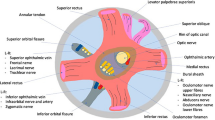Play all audios:

ABSTRACT Summary: Nine patients with aberrations in development and placement of the eyes and periocular structures who also had serious defects in central nervous system development were
evaluated in order to better understand normal ocular development. Included were an incompletely developed twin stillborn infant who lacked both eyes and the nose, a stillborn infant with
cyclopia bypognathia, 6 spontaneous abortuses with varying degrees of holoprosencephaly, and a 17-year-old male with a serious defect in central nervous system development whose right eye
was positioned laterally above the right ear. In all cases, evidence indicates that orbital and periocular structures are determined by the underlying optic vesicle rather than independently
derived as has been suggested by previous studies. Speculation: The intimate developmental relationship between the forebrain and structures of the upper face suggests that alterations of
periocular and bony orbital structure and placement may well reflect defects in underlying brain development. SIMILAR CONTENT BEING VIEWED BY OTHERS TOPOGRAPHICAL ANATOMY OF THE ANNULUS OF
ZINN Article Open access 20 January 2022 THE VARIETIES OF JUNCTIONAL SCOTOMA: 17 CASES, A REVIEW, AND A TAXONOMY Article 22 April 2025 ORBITAL APEX ANATOMY: RELATIONSHIP BETWEEN THE OPTIC
FORAMEN AND ANTERIOR FACE OF SPHENOID SINUS — A RADIOLOGICAL STUDY Article 22 November 2020 ARTICLE PDF AUTHOR INFORMATION AUTHORS AND AFFILIATIONS * Department of Pediatrics, University of
California, San Diego School of Medicine, La Jolla, 92093, California, USA Kenneth Lyons Jones & Marilyn C Higginbottom * Department of Pediatrics, Dysmorphology Unit, University of
Washington School of Medicine, Seattle, Washington, USA David W Smith Authors * Kenneth Lyons Jones View author publications You can also search for this author inPubMed Google Scholar *
Marilyn C Higginbottom View author publications You can also search for this author inPubMed Google Scholar * David W Smith View author publications You can also search for this author
inPubMed Google Scholar RIGHTS AND PERMISSIONS Reprints and permissions ABOUT THIS ARTICLE CITE THIS ARTICLE Jones, K., Higginbottom, M. & Smith, D. Determining Role of the Optic Vesicle
in Orbital and Periocular Development and Placement. _Pediatr Res_ 14, 703–708 (1980). https://doi.org/10.1203/00006450-198005000-00001 Download citation * Issue Date: 01 May 1980 * DOI:
https://doi.org/10.1203/00006450-198005000-00001 SHARE THIS ARTICLE Anyone you share the following link with will be able to read this content: Get shareable link Sorry, a shareable link is
not currently available for this article. Copy to clipboard Provided by the Springer Nature SharedIt content-sharing initiative KEYWORDS * bony orbital structures * central nervous system
defects * development * optic nerve * periocular structures
